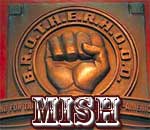| Author
|
Spectrum
|
S7a5
IsraTrance Junior Member

Started Topics :
12
Posts :
62
Posted : Jan 10, 2005 16:43
|
Hi everyone
I was lookin into the forum forst b4 posting this topic because I caould find a clear answer.
ok so I know that the entire mixdown must sit between about 20 hz and 19 Khz. As you know in most psytrance the bassline and the kick is always present throughout the track and may conflict between each other if not placed properly. So my question is in what spectrum should i give more room (boost) to kick and bass? I know they sit very close from each other buthow do I separate them from each other so that they both sound tight? I ran a lot of spectrum analyzers such as Firium and I found out that there is a slight boost around 50-70 hz area but I still cant understand either its a kick or bass occupies this are 
tx a lot
|

|
|
fuzzikitten
Annunaki

Started Topics :
40
Posts :
603
Posted : Jan 10, 2005 17:40
|
S7a5,
Obviously different people will prefer different frequencies, but here's what I've found to work for me:
I like my kick to hit the listener right in the base of the spine and have the bassline thump right in the chest. The chest is best 'thumped' in the second and fourth octaves (65-493Hz http://www.phy.mtu.edu/~suits/notefreqs.html ), so I try to make this region the bass region.
First I determine the key of my bassline and what the frequency of the key is in the second octave. For instance, if my bassline were in the key of D, the frequency of D in the second octave (D2) is 73.42Hz. This becomes the lower limit for my bassline.
Second I determine how high up the frequency spectrum I want my bass to sit. Usually this is around the third or fourth octave (D3 or D4), depending on the rest of the mix. So if my bassline is in D I might set the upper limit to about 293Hz (D4).
So my bassline (in the key of D) will 'sit' between 73.42Hz and 293Hz. I do this by cutting absolutely everything below 73.42Hz and carefully cutting above 293Hz on the bassline, and cutting a little on the kick between 73.42Hz and 293Hz. Basically I create a hole in my kick between 73.42Hz (D2) and 293Hz(D4) that the bass peeks out through. I don't kill the kick in that region, but just tone it down enough so that the bass can be heard more.
Above 293Hz I still let some of the bass peek through, but I try to blend the kick and bass so that they both live in this region. If my bass gets drowned out by other elements later in the mix I might give it a little room around 1kHz so that it can be heard better.
Basically I try to make the kick the most prominent from 25-65ishHz, the bass the most prominent from 65-293Hz, and then have the kick and bass share the space from 300Hz and up. I also roll them both off around 1kHz to leave room for the other elements (though I might roll them off around 500Hz if I want some deep leads).
Also I do a lot of selective EQing on the bass and kick, making sure there aren't any nasty frequencies that jump out when the two play together. Sometimes I also do side-chaining compression (just a little) so that the bass and kick behave well when they sound together.
Hope that helps!
-Alex
|

|
|
Mike A
Subra

Started Topics :
185
Posts :
3954
Posted : Jan 10, 2005 17:42
|
The first step in seperating kick & bass is making sure there are no kick & bass at the same time.
Try to shorten your kick (most of the time kicks are just too damn long), and make sure that you keep the bassline & kick overlaps to a minimum.
Once you're done with that, side-chain compression can help you quite a bit, use the search for that.
After you've done that - now it's the time for eqing to make sure they sound both tight as one.
|

|
|
S7a5
IsraTrance Junior Member

Started Topics :
12
Posts :
62
Posted : Jan 11, 2005 22:18
|
Thanks a lot for your response fuzzikitten 
So as I undesrtand your post is something similar to this pic
www.picturehost.co.uk/free.one/Kick%20and%20Bass.JPG
So if my bass, lets say, has a key of "C" it should therefore be more prominent in 65-261 Hz range right?
What exactly did you mean by side-chain compression? Is there is any useful tutorials on that? (I looked on net couldn't find anything relevant) 
Usually I apply Waves R-Bass compression and then use R-Vox to give it more power but still it doesnt seem to sit tight and give some concrete "woof".
Thanks a lot
|

|
|
fuzzikitten
Annunaki

Started Topics :
40
Posts :
603
Posted : Jan 11, 2005 22:41
|
|
S7a5
IsraTrance Junior Member

Started Topics :
12
Posts :
62
Posted : Jan 14, 2005 00:55
|
10x
thanks mate  |

|
|
Get-a-fix
Getafix

Started Topics :
147
Posts :
1441
Posted : Jan 29, 2005 18:57
|
fuzzikitten:
I do this by cutting absolutely everything below 73.42Hz and carefully cutting above 293Hz on the bassline, and cutting a little on the kick between 73.42Hz and 293Hz. Basically I create a hole in my kick between 73.42Hz (D2) and 293Hz(D4) that the bass peeks out through.
how would i do this? by converting it into audio and editing it in cubase or sound forge? could u explain this in detail please..thanks a lot
        http://www.soundcloud.com/getafixmusic http://www.soundcloud.com/getafixmusic |

|
|
NikC
BeatNik

Started Topics :
40
Posts :
601
Posted : Jan 30, 2005 01:43
|
By cutting do you mean something like a highpass?...
I always thought that the frequencies from 35Hz upward were all important in the depth of the bass as a whole (including basslin and kick) and also that the bassline should have lower frequencies in it than the kick...
Have i just messed up bass-wise? (it seems to have worked so far :s)
I can understand letting the bass poke through the kick, but maybe i'm just not understanding well 
Peace  |

|
|
fuzzikitten
Annunaki

Started Topics :
40
Posts :
603
Posted : Jan 30, 2005 17:43
|
Psycho - I do the cutting with an EQ. Specifically I use Q10, but any parametric EQ should work.
As NikC said, use a highpass on the bass to cut everything below 73.42Hz. Then use a lowpass to cut anything above around 293Hz (though sometimes I'll boost around 500 or 1000Hz to give the bass 'bite'). Then use a parametric EQ to cut a 'hole' in the kick, using an EQ with a high Q (maybe around 4-7) and reducing at 160Hz a few decibels, just enough to bring the kick in that frequency range down a little bit.
The idea here is simply to have the most crucial frequencies of the bass dominate the kick, but otherwise (the rest of the frequencies) let the kick dominate.
If what I said doesn't make sense, then this link will provide more than enough info on EQing.  http://www.ethanwiner.com/equalizers.html http://www.ethanwiner.com/equalizers.html
NikC - You haven't messed up if it sounds good! What I've suggested here is NOT the 'right' way to do it, it's just the way I've found that gives a sound I like. Personally I like the kick to sit under the bass (hitting at the base of the spine) and let the bass hit in the chest. But that's just my preference.
I have found that with bass, cutting some of the frequencies (even above 35Hz) can help make it seem punchier, especially from 500-1000Hz (that's all mud imo).
But, as always, if it sounds good then it's another 'right' way.  |

|
|
Spindrift
Spindrift

Started Topics :
33
Posts :
1560
Posted : Jan 30, 2005 18:17
|
Sometimes I get a bit concerned with the way many discussions here go when it comes to EQ and compression.
They are tools to fix problems with sounds, and should not be used on routine all the time.
A good kick and bass comes from having good kick and bass sounds.
If they sound good together, then that's fine and you do not need to separate them more.
If they clash there is a problem with your sequencing or the sounds, not with your EQ or sidechaining.
I hear so much music where you clearly can hear that the bass is overcompressed or over EQ'ed.
It's by far the most common beginner mistake leading to a bad mix to do to much EQ'ing and compression.
And this frenetic cutting away of all sub frequencies is maddness IMO.
Much of the released full-on stuff suffers badly from to thin bass sounds in my ears.
Sure if you have monitors that only go to 50hz it will sound better if you clean away all you cannot hear.
There is systems that go down to 20hz though, and on those systmes your track will sound obviously thinner.
To cut away everything below 73.42 hz will make you sound in line with fullon producers using synths like the VB-1.
Sure you get punch and tighness, that lies between 70 and 120 hz, but all in all it sounds really boring and shallow in my taste if you have no subbass whatsoever.
        (``·.¸(``·.¸(``·.¸¸.·`´)¸.·`´)¸.·`´) (``·.¸(``·.¸(``·.¸¸.·`´)¸.·`´)¸.·`´)
« .....www.ResonantEarth.com..... »
(¸.·`´(¸.·`´(¸.·`´``·.¸)``·.¸)``·.¸)
http://www.myspace.com/spindriftsounds
http://www.myspace.com/resonantearth |

|
|
Morax
Triac

Started Topics :
10
Posts :
348
Posted : Jan 30, 2005 19:30
|
i think that if you seperate the kick and the bass completely, cutting one sound when the other appears its the easiest way to get "good sound" without any headake.
i mean the kick and the bass is in totaly different times so theres no way that the mix between them gonna make any volume peaks, so why the hell you need to EQ in this situation ?!@%
(of course you need eq to get the color you want for the kick and the bass as rest of the sound but its not connected to the production).
i personaly think that the best result will be the best flow of the specific situation.
if the kick need to be cut, than its cool, if you need to use compressor, its cool too. if you need just to eq the kick or the bass, its cool too, but each combo has its own character and each case is different and theres no "easy way to get good results". i dont think that cutting the kick when bass appears or not to write bass notes on the kick is the right way to make a good music with best production, i think to get an original track with good production you need just to sit on your damn ass for a loooong time and do something that will sound great and has a new idea.
if we will all make the same we will all soud the same.
imo, reading the book of Bob Katz will give you the best start how to look on production from a different angle (and mastering also).
cheers |

|
|
Spindrift
Spindrift

Started Topics :
33
Posts :
1560
Posted : Jan 30, 2005 19:49
|
Quote:
|
of course you need eq to get the color you want for the kick and the bass
|
|
I'm sure though that if you read what Katz have to say abou EQ'ing or compression he wont agree.
Of course he is more from a pure production angle, and most of us are discussing this from the angle of a producer and musician at the same time, hence the IMO confusing advice that seem to be prominent in discussions about EQ'ing and compression here.
Usually in traditional studio circumstances a lot of the burden of creating a good sound used to be on the musician.
If it was having a well maintained quality violin, or a good guitar with a nice combination of amp and fx pedals.
The producer would then ideally not have to do a lot of EQ and compression, just set the levels, add maybe some reverb and delay and have a great sounding mix.
Of course everything is rarely sounding perfect, so EQ's and compressors was applied to fix any eventual problems.
When you sequence it's quite easy though to control things quite well, and the need for corrective measures should be minimal.
Still it seems like EQ and compression is considered a lot more important in our scene.
Probably because people seem to be taught that thats how you get good sound, and forget to find the best sounding instrument for a task and focus on using that instrument in the right way.
Instead they reach for an EQ and compressor in hope of polishing the turd.
I quite much agree with paul white on this subject:
Quote:
|
My own rule is to avoid compression (or any other form of treatment) unless it's absolutely necessary. Even with vocals, if somebody gives me a perfectly controlled vocal take, I wouldn't want to compress it just because compressing vocals is the done thing. Compression is a very valuable studio tool, but like all tools, it is just a means to an end—not an end in itself.
|
|
        (``·.¸(``·.¸(``·.¸¸.·`´)¸.·`´)¸.·`´) (``·.¸(``·.¸(``·.¸¸.·`´)¸.·`´)¸.·`´)
« .....www.ResonantEarth.com..... »
(¸.·`´(¸.·`´(¸.·`´``·.¸)``·.¸)``·.¸)
http://www.myspace.com/spindriftsounds
http://www.myspace.com/resonantearth |

|
|
WAVELOGIX
Wavelogix

Started Topics :
136
Posts :
1214
Posted : Jan 30, 2005 20:30
|
Quote:
|
On 2005-01-10 17:40, fuzzikitten wrote:
S7a5,
I like my kick to hit the listener right in the base of the spine and have the bassline thump right in the chest. The chest is best 'thumped' in the second and fourth octaves (65-493Hz http://www.phy.mtu.edu/~suits/notefreqs.html ), so I try to make this region the bass region.
First I determine the key of my bassline and what the frequency of the key is in the second octave. For instance, if my bassline were in the key of D, the frequency of D in the second octave (D2) is 73.42Hz. This becomes the lower limit for my bassline.
Second I determine how high up the frequency spectrum I want my bass to sit. Usually this is around the third or fourth octave (D3 or D4), depending on the rest of the mix. So if my bassline is in D I might set the upper limit to about 293Hz (D4).
So my bassline (in the key of D) will 'sit' between 73.42Hz and 293Hz. I do this by cutting absolutely everything below 73.42Hz and carefully cutting above 293Hz on the bassline, and cutting a little on the kick between 73.42Hz and 293Hz. Basically I create a hole in my kick between 73.42Hz (D2) and 293Hz(D4) that the bass peeks out through. I don't kill the kick in that region, but just tone it down enough so that the bass can be heard more.
Above 293Hz I still let some of the bass peek through, but I try to blend the kick and bass so that they both live in this region. If my bass gets drowned out by other elements later in the mix I might give it a little room around 1kHz so that it can be heard better.
Basically I try to make the kick the most prominent from 25-65ishHz, the bass the most prominent from 65-293Hz, and then have the kick and bass share the space from 300Hz and up. I also roll them both off around 1kHz to leave room for the other elements (though I might roll them off around 500Hz if I want some deep leads).
|
|
very lame advice imo ... this is surely not the way you eq channels my frnd ... maybe u could post a sample of your kik , bass ... so that i could lissen to what exactly you do .. |

|
|
billy ambulance
IsraTrance Junior Member

Started Topics :
43
Posts :
560
Posted : Jan 31, 2005 15:38
|
fuzzikitten , thats not the way to make bass
cutting the bass above 260hz will get you nowhere!!
your loosing a lot of upper tones of the bass.
cut the bass above 700hz-1500hz by you own taste.
these days alot of artists make thier bass wide with alot of punch (very open in the highs) so there are no really rules about it, the key word is expirience
|

|
|
psypox
Psypox / Bufo

Started Topics :
53
Posts :
768
Posted : Jan 31, 2005 15:54
|
i lowcut my bass at 20-50, so it dont get muddy....
and let my FX leads and pads be over 200
        www.myspace.com/psypox www.myspace.com/psypox |

|
|